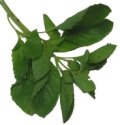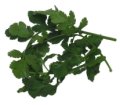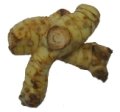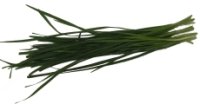Introduction to oriental herbs
This is a brief introduction to herbs commonly used in oriental cuisine. Herbs play a very important role in oriental cooking, imparting their distinct flavours in various combinations to form the basis of many dishes. Naturally, we stock all of these herbs, so if you feel like exciting your taste buds why not pop in-store and experience them for yourself?
Thai Sweet Basil (Bai Horopa)
Thai sweet basil is a close cousin of the Mediterranean basil that you may be more familiar with and is used not only in Thai cooking, but Vietnamese and Loatian cuisine too. Its subtle taste lends itself well to curries and stir fry dishes. Not to be confused with Holy Basil Thai sweet basil has an anise taste and smooth deep green leaves rather than the slightly hairy Holy Basil that tastes like cloves. The leaves are generally thrown whole or roughly chopped into stir-fry dishes and stews.
Holy Basil (Tulsi)
Holy Basil features heavily in Hindu ritual and tradition and is considered to have medicinal properties, particularly for treating stress. More recently, Holy Basil’s clove-like taste has found its way into Asian cuisine. It is generally used in a similar way to Thai Sweet Basil
Coriander (Chinese Parsley, Cilantro)
Coriander is a popular herb that is used in not only Asian cuisine, but also Central and South American cooking too. It has a fresh citrus taste and is usually chopped roughly and added immediately before a dish is served to ensure that the flavour is not destroyed by the heat.
Galangal (Thai Ginger)
Often referred to as Thai Ginger, Galangal, although not as popular in Chinese cuisine, features heavily in Thai food. It has a slightly soapy pine-like flavour and is an important ingredient in Thai curry pastes. It is used in a similar way to ginger – it is peeled and either grated or chopped finely.
Garlic Chives (Chinese Chives)
Chinese Chives do not taste much like ordinary chives, but more like a subtle garlic. It is used in a similar manner to chives or garlic and is most simply used as a stir-fry ingredient. They feature in Chinese dim sum too, added to pan-fried or steamed dumplings with pork and prawns.
Ginger
Ginger features heavily in oriental cuisine. It is paired up with garlic to form the base of many dishes. Ginger provides a subtle warmth and zing to both sweet and savoury dishes unlike the more obvious heat of chilli. Fresh ginger is firm to the touch and has a taut skin with a slight sheen. The skin is peeled off and it is generally grated or finely sliced into small matchsticks or slices. It is commonly steamed with fish in Chinese cuisine.
Lemongrass
Lemongrass is a hard grass with a strong lemon aroma and is commonly used across eastern countries. There are a few ways of cooking with it: Sometimes it is bruised and placed into stews and curries, to be removed before serving. It may also be chopped finely before placing into food, imparting a much greater flavour, in which case it need not be removed. Why not also consider using them as skewers?
Kaffir Lime Leaves
These leaves have a zesty lime flavour that is commonly used in Cambodian, Thai, and Laotian cuisine. Kaffir lime leaves are especially popular in chicken and fish dishes but can just as easily feature in sweet dishes. Kaffir lime leaves are used in a similar way to bay leaves, which are added to a dish at the beginning and removed just before serving.
